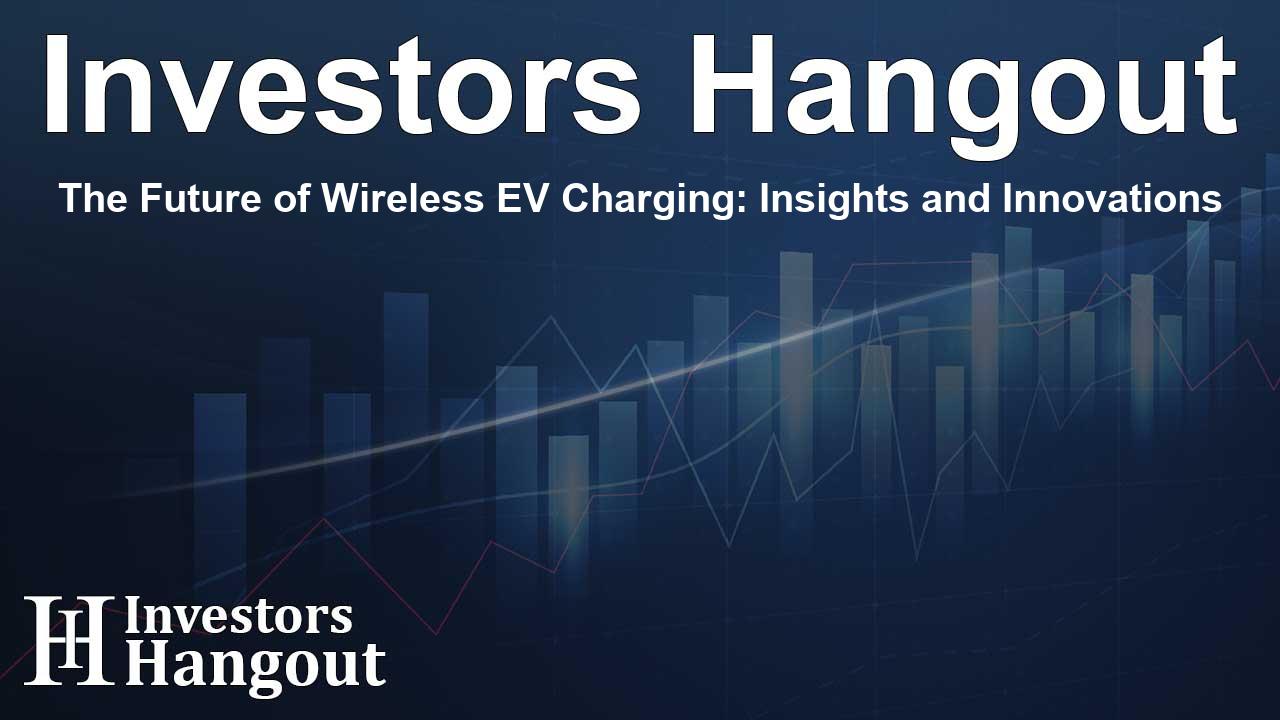The Future of Wireless EV Charging: Insights and Innovations

Transforming the Automotive Landscape with Wireless EV Charging
The global wireless EV charging market is anticipated to experience significant growth, escalating from a valuation of approximately US$ 1,172.28 million to around US$ 4,119.51 million within the next decade. This growth, representing a compound annual growth rate (CAGR) of 13.64% from the coming years, underscores the pivotal changes taking place in the automotive sector.
As electric vehicle (EV) sales continue to surge, with over 17 million units sold globally recently, the demand for innovative charging solutions has never been more pressing. The emergence of wireless charging technology is set to redefine the landscape, offering improved convenience and efficiency to drivers. With the U.S. aiming for 50% electric vehicle sales by 2030, it's essential that the infrastructure evolves to meet this demand in a seamless manner.
Performance Enhancements in Wireless EV Charging
Recent advancements have demonstrated that wireless EV charging is no longer just a convenience—it rivals the performance of traditional charging methods. For instance, innovative research conducted at leading laboratories has led to systems capable of delivering 100 kW of power at an impressive efficiency rate of 96%. This means that vehicles can gain a sufficient charge, improving the efficiency and experience for EV owners.
Noteworthy is a significant rise in power levels that can be achieved wirelessly, illustrating the rapid evolution of this technology. Companies are developing systems that range from 3.6 kW to 50 kW, effectively broadening the possibilities for types of vehicles served. This leap in performance is set to accelerate the acceptance of wireless charging in daily use.
Standardization as a Key Driver of Adoption
For any new technology, particularly in the automotive sector, establishing reliable standards is crucial. The SAE International J2954 standard serves as a benchmark for inductive charging systems, ensuring compatibility and interoperability among various EVs and charging stations. The regulations define specific power levels and efficiency benchmarks, which facilitate wider adoption of the technology across consumers and manufacturers alike.
Moreover, advancements like the Differential Inductive Positioning System (DIPS) will allow for seamless connections during the charging process, regardless of external conditions. As these standards continue to evolve, the pathway for widespread acceptance and integration of wireless EV charging systems becomes clearer.
Exploring Market Segmentation: The Dynamic and Static Charging Divide
The industry of wireless charging is developing along two primary lines—static and dynamic charging systems. Static charging allows for charging when vehicles are parked and has seen significant advancements in technology and standardization. In contrast, dynamic charging proposes a groundbreaking method where vehicles are charged as they drive, eliminating the range anxiety traditionally associated with electric vehicles.
Exciting pilot projects worldwide exemplify the feasibility of dynamic charging. For instance, urban projects testing in-motion charging are already in operation. These innovations promise to noticeably lower costs related to battery sizes, as EVs could charge while operating on the road.
Innovators Shaping the Wireless EV Charging Landscape
This dynamic industry landscape boasts a mix of established automotive brands and innovative tech firms, all vying for leadership. Players like WiTricity, which has roots in MIT engineering, are at the forefront, while others like InductEV and HEVO Inc. are also making significant strides in wireless technology. The competitive drive in this sector encourages rapid technological advancements that could redefine electric mobility.
Additionally, patents in the wireless charging field indicate a robust environment for innovation, with major corporations leading the charge in intellectual property development. This race for patents serves as a proxy for the anticipated growth and competitiveness within the industry.
Government Initiatives Fueling Market Growth
Facilitating this rapidly growing market is substantial government investment. Recent federal funding initiatives aimed at developing EV infrastructure, like the Bipartisan Infrastructure Law, allocate billions specifically for enhancing electric vehicle charging frameworks. This financial backing is instrumental in accelerating development and lowering the barriers to entry for new technologies in the market.
Consumer Interest Fuels Adoption Rates
Ultimately, the success of wireless charging technology hinges on consumer interest and demand. Surveys reveal an overwhelming 81% of prospective EV buyers express great enthusiasm for wireless charging options. The potential of this technology can greatly influence purchasing decisions as more individuals seek convenience and efficiency in their charging solutions.
As familiarity with wireless charging grows, especially from experiences with personal electronic devices, consumer willingness to transition to wireless charging for electric vehicles will likely increase, shaping a new market trajectory.
Expanding Opportunities Beyond Passenger Vehicles
The applications for wireless EV charging extend far beyond the personal vehicle domain. The rise of autonomous vehicles will likely necessitate self-charging capabilities, while commercial fleets could achieve operational efficiencies with inductive charging at distribution hubs. The potential for public transit systems to incorporate dynamic charging could lead to groundbreaking improvements in efficiency and service continuity.
Evolving Market Dynamics and Future Prospects
Despite notable challenges, the outlook for wireless EV charging technology is optimistic. Initial installation costs remain elevated compared to conventional systems, yet as the industry standardizes and builds scale, these expenses should begin to decrease. The desire for convenience and advances in technology suggest that a fully wireless future for electric vehicles is not just plausible, but imminent.
Frequently Asked Questions
What is the projected growth of the wireless EV charging market?
The wireless EV charging market is projected to grow from US$ 1,172.28 million to approximately US$ 4,119.51 million by 2034.
What are the key performance metrics for wireless charging?
Recent advancements show wireless systems can achieve efficiencies of up to 96% with power levels ranging from 3.6 kW to 50 kW.
How does government policy influence this market?
Government initiatives provide significant funding to bolster the EV infrastructure, enabling the growth of wireless charging solutions.
What are the different types of wireless charging systems?
Wireless charging systems primarily include static charging for parked vehicles and dynamic charging for vehicles while in transit.
How does consumer interest affect the adoption of wireless EV charging?
Strong consumer demand, with 81% of prospective buyers expressing interest, significantly boosts the likelihood of adopting wireless charging technologies.
About The Author
Contact Dominic Sanders privately here. Or send an email with ATTN: Dominic Sanders as the subject to contact@investorshangout.com.
About Investors Hangout
Investors Hangout is a leading online stock forum for financial discussion and learning, offering a wide range of free tools and resources. It draws in traders of all levels, who exchange market knowledge, investigate trading tactics, and keep an eye on industry developments in real time. Featuring financial articles, stock message boards, quotes, charts, company profiles, and live news updates. Through cooperative learning and a wealth of informational resources, it helps users from novices creating their first portfolios to experts honing their techniques. Join Investors Hangout today: https://investorshangout.com/
The content of this article is based on factual, publicly available information and does not represent legal, financial, or investment advice. Investors Hangout does not offer financial advice, and the author is not a licensed financial advisor. Consult a qualified advisor before making any financial or investment decisions based on this article. This article should not be considered advice to purchase, sell, or hold any securities or other investments. If any of the material provided here is inaccurate, please contact us for corrections.
